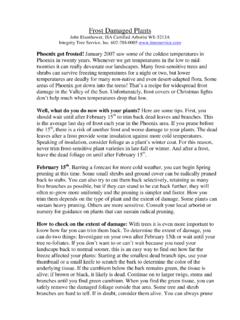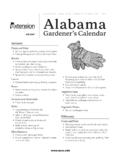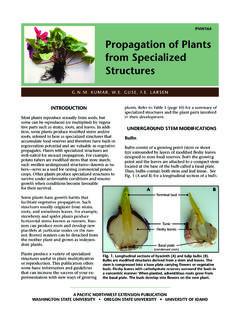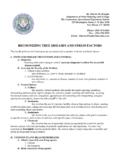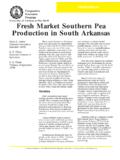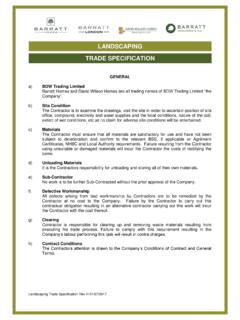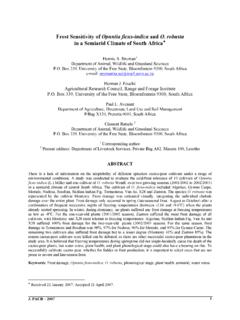Transcription of PLANTS FOR PONDS AND PENS - British Waterfowl Association
1 Registered Charity No. 263156 British Waterfowl Association 01531 671250 PLANTS FOR PONDS AND pens I N F O R M A T I O N S H E E T Duck enclosures need not be muddy, bare, unattractive areas of your garden. With careful planning and a little foresight, pens can be made attractive to the eye and thus enhance the beauty of the residents. STOCKING It is easier to create and landscape an enclosure for wildfowl and bantam ducks than it is for heavy domestic ducks and geese. The main priority when keeping heavy domestic ducks and geese must be to maintain sufficient grass, it is virtually impossible to landscape successfully with PLANTS alone. Sufficient grass in any enclosure is essential if the pen is to remain attractive throughout the year.
2 As a general rule, if the grass does not require cutting in the summer, then you are perhaps over stocked with birds. One cannot over emphasise the problems that overcrowding can cause. Experience and time will teach you how to maintain the balance between ducks and PLANTS . Don t forget many species of swan, geese and ducks graze prolifically, so good grass is essential in any landscaping scheme. A suitable resilient mixture will depend on your individual situation but recommended varieties to include are perennial rye grass, cocksfoot, fescues, timothy and white clover. POND ESSENTIALS Before embarking on a planting regime it is important to consider the pond. No matter what the pond style, if they are to survive ducks constant puddling, all PONDS require suitable reinforcement around the edges.
3 This will serve to prevent banks being eroded away, stop mud around the area becoming a problem and protect roots of surrounding PLANTS . In a moderate sized pen with either a small or natural pond, pea-gravel spread around the perimeter of the water forms an attractive feature. For larger PONDS materials can vary from larger stones to paving or timber. A variety of depths of water with reinforced banks will help establish good bank-side cover and support a small population of duck without detriment to the pond. However, where there is no running water, or where there is heavier stocking a filtration system may well be Registered Charity No. 263156 British Waterfowl Association 01531 671250 required.
4 All PONDS will require occasional de-silting and removal of unwanted plant growth. Your planting scheme should allow for this to be done by hand or machinery with minimal damaged to existing vegetation. Work of this kind should be carried out in the autumn/winter to avoid disturbance of breeding birds and to allow vegetation to recover in spring. For planting, a shelf with a gradient of 1:2, or even 1:3 will create ideal conditions for marginal vegetation and prevent further encroachment into the pond once the depth gets to Waterfowl will need a shallow sloping edge for safe entrance and exit to the pond as well an area on the bank, clear of planting, for standing, sunbathing and preening. PLANTING Assuming that the pond, the area of the enclosure and the Waterfowl are reasonably balanced, it is perfectly feasible to plant successfully for the enjoyment of all.
5 Ideally the enclosure should be planted and established before birds are introduced. Should you have to plant after the arrival of your birds, then your PLANTS and flowers must be protected, until they are fully established. 25mm wire netting, 50cm high, placed around each plant will provide this protection and prevent the PLANTS being destroyed by the inmates. The construction and layout of the pen should be attractive but practical. One should plant with the intention of providing adequate cover for nesting birds, plus shade in the summer and protection in the winter. Remember that too much planting will obscure your birds! It is vital to take in the nature of the surrounding environment and plant accordingly. Choices for a garden or park pond, for example, are not necessarily suited to the creation of a natural or wildlife pond where you should stick to the use of native or naturalised PLANTS .
6 Before embarking on a planting programme, assess the soil and water in order that suitable PLANTS can be chosen, for example: is the soil acidic or alkaline, sandy or nutrient rich; is the water is shallow or deep, still or moving? Care in planning will help ensure good establishment and survival. On the whole native species of local provenance will grow best and provide the right habitat for Waterfowl and other wildlife. Be very careful transplanting vegetation from another pond to ensure that you do not transfer non-native species that are disastrous for pond life such as Parrot s feather, Floating pennywort, Water primrose, Water fern and New Zealand pygmy-weed (also called Australian swamp stonecrop). I N F O R M A T I O N L E A F L E T PLANT VARIETIES There are very few PLANTS that your geese and ducks won t eat, in particular they enjoy new growth but some PLANTS stand up to Waterfowl better than others once well established.
7 PLANTS are as important as the water itself; providing food, harbouring insects and aquatic life, giving valuable shelter, offering cover from predators and allowing sites for nesting and protection for ducklings in their first few weeks. In any planting scheme only a small number of species need be introduced as in most cases these will spread rapidly once established. The aim should be to create a plant profile using species from each of four categories below. Registered Charity No. 263156 British Waterfowl Association 01531 671250 Trees and shrubs Marginal PLANTS Submerged PLANTS Free-floating PLANTS Trees and shrubs should be planted back from the water s edge to provide shelter from the prevailing wind and useful breaks from sun, frost or snow.
8 Small trees and bushes near the waters edge may also provide a frost free spot on the water and a supply of invertebrates to the pond but excessive shading and leaf litter will affect the water quality so should be avoided. Shrubs can provide good low level bushy cover for nesting and breeding. However, too much shrubbery or undergrowth along the banks will harbour vermin. For natural planting popular choices of tree include Alder, Willow, Oak and Birch. Oak must be planted well back from the waters edge. Willow is particularly useful as it is attractive, quick and easy to grow. There are Willow varieties suitable for smaller sites, such as Contorted Willow, as well as for coppicing. Smaller trees such as Cherry, Rowan, Elderberry, Flowering Crabs and thorns are also good choices that are both ornamental and provide valuable food for birds.
9 Beech hedging and Dogwood provide good windbreaks whilst Bramble and Gorse are fairly inedible and give good nesting cover too. For more formal parks and gardens, evergreen trees and shrubs supply excellent shade in the summer and protection in the winter. Cypress and Juniper types offer a wide variety of sizes, forms and colours. Norway spruce, Larch and Cedar are popular choices but for those with smaller gardens dwarf varieties are ideal being both slow growing and non-invasive. Flowering evergreen and semi-evergreen shrubs such as Berberis, Broom, Choisya, Pieris and Pyracantha add colour and interest to any planting scheme, whilst Box, Cotoneaster, Eleagnus and Lonicera nitida are particularly useful for screening items such as nest boxes.
10 Bamboo is an excellent focal point or screen that adds an exotic feel and gives all year round cover and nesting material. Other popular shrubs for colour, interest, nesting cover or attracting insects include: Buddleia and Spiraea; smaller Potentilla, Rock Rose and Heathers; as well as ground cover PLANTS such as Periwinkle. Marginal PLANTS tend to tolerate fluctuating water levels, growing from dry ground at the waters edge down to water depths of 1m or more. They help stop bank erosion, provide cover for birds, attract invertebrates and aid the survival of ducklings. Sedges, reeds and flags are all good marginal PLANTS that provide an ideal habitat for both ducks and their insect food. These do need to be well established before introducing ducks unless you cover the roots with fine wire mesh or erect a temporary protective fence.
